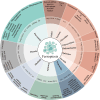Recent advances in the potential effects of natural products from traditional Chinese medicine against respiratory diseases targeting ferroptosis
- PMID: 38519984
- PMCID: PMC10958864
- DOI: 10.1186/s13020-024-00918-w
Recent advances in the potential effects of natural products from traditional Chinese medicine against respiratory diseases targeting ferroptosis
Abstract
Respiratory diseases, marked by structural changes in the airways and lung tissues, can lead to reduced respiratory function and, in severe cases, respiratory failure. The side effects of current treatments, such as hormone therapy, drugs, and radiotherapy, highlight the need for new therapeutic strategies. Traditional Chinese Medicine (TCM) offers a promising alternative, leveraging its ability to target multiple pathways and mechanisms. Active compounds from Chinese herbs and other natural sources exhibit anti-inflammatory, antioxidant, antitumor, and immunomodulatory effects, making them valuable in preventing and treating respiratory conditions. Ferroptosis, a unique form of programmed cell death (PCD) distinct from apoptosis, necrosis, and others, has emerged as a key area of interest. However, comprehensive reviews on how natural products influence ferroptosis in respiratory diseases are lacking. This review will explore the therapeutic potential and mechanisms of natural products from TCM in modulating ferroptosis for respiratory diseases like acute lung injury (ALI), asthma, pulmonary fibrosis (PF), chronic obstructive pulmonary disease (COPD), lung ischemia-reperfusion injury (LIRI), pulmonary hypertension (PH), and lung cancer, aiming to provide new insights for research and clinical application in TCM for respiratory health.
Keywords: Ferroptosis; Mechanism; Natural products; Respiratory diseases; TCM.
© 2024. The Author(s).
Conflict of interest statement
The authors declare that they have no competing interests.
Figures



Similar articles
-
Targeting ferroptosis regulators in lung cancer: Exploring natural products.Heliyon. 2024 Jul 2;10(14):e33934. doi: 10.1016/j.heliyon.2024.e33934. eCollection 2024 Jul 30. Heliyon. 2024. PMID: 39104501 Free PMC article. Review.
-
Traditional Chinese medicine for pulmonary fibrosis therapy: Progress and future prospects.J Ethnopharmacol. 2017 Feb 23;198:45-63. doi: 10.1016/j.jep.2016.12.042. Epub 2016 Dec 28. J Ethnopharmacol. 2017. PMID: 28038955 Free PMC article. Review.
-
Ferroptosis and Traditional Chinese Medicine for Type 2 Diabetes Mellitus.Diabetes Metab Syndr Obes. 2023 Jun 26;16:1915-1930. doi: 10.2147/DMSO.S412747. eCollection 2023. Diabetes Metab Syndr Obes. 2023. PMID: 37398945 Free PMC article. Review.
-
A systematical review on traditional Chinese medicine treating chronic diseases via regulating ferroptosis from the perspective of experimental evidence and clinical application.Chin Herb Med. 2025 Jan 21;17(2):246-260. doi: 10.1016/j.chmed.2025.01.003. eCollection 2025 Apr. Chin Herb Med. 2025. PMID: 40256717 Free PMC article. Review.
-
Research progress on the use of traditional Chinese medicine to treat diseases by regulating ferroptosis.Genes Dis. 2024 Nov 6;12(3):101451. doi: 10.1016/j.gendis.2024.101451. eCollection 2025 May. Genes Dis. 2024. PMID: 40070365 Free PMC article. Review.
Cited by
-
The molecular and metabolic landscape of ferroptosis in respiratory diseases: Pharmacological aspects.J Pharm Anal. 2025 Jan;15(1):101050. doi: 10.1016/j.jpha.2024.101050. Epub 2024 Jul 24. J Pharm Anal. 2025. PMID: 40034685 Free PMC article. Review.
-
PEBP1 and 15-LO-1 in Asthma: Biomarker Potential for Diagnosis and Severity Stratification.Diagnostics (Basel). 2025 May 24;15(11):1322. doi: 10.3390/diagnostics15111322. Diagnostics (Basel). 2025. PMID: 40506894 Free PMC article.
-
Chronic obstructive pulmonary disease: in-depth analysis of microbiota association and innovative prevention and treatment approaches from the gut-lung axis perspective.Front Immunol. 2025 Jul 30;16:1549865. doi: 10.3389/fimmu.2025.1549865. eCollection 2025. Front Immunol. 2025. PMID: 40808958 Free PMC article. Review.
-
Ferroptosis in pulmonary fibrosis: pathogenesis and traditional Chinese medicine-driven therapeutic approaches.Front Cell Dev Biol. 2025 Jul 18;13:1598924. doi: 10.3389/fcell.2025.1598924. eCollection 2025. Front Cell Dev Biol. 2025. PMID: 40756260 Free PMC article. Review.
-
Phytochemicals as modulators of ferroptosis: a novel therapeutic avenue in cancer and neurodegeneration.Mol Biol Rep. 2025 Jun 25;52(1):636. doi: 10.1007/s11033-025-10752-4. Mol Biol Rep. 2025. PMID: 40560244 Review.
References
Publication types
Grants and funding
LinkOut - more resources
Full Text Sources

